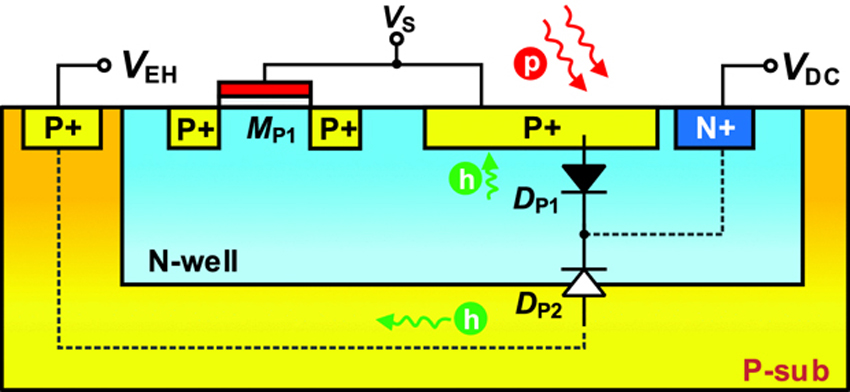 Active CMOS sensor
Active CMOS sensorA group of engineers led by Yui Sik Yun from the University of Michigan USA created a photosensor, where almost the entire pixel area occupies an area that can simultaneously generate energy and form an image. This allows you to make a self-sufficient camera area of less than a square millimeter. At the same time, it is able to shoot a decent quality at a frequency of 15 frames per second. The developers have published their work in the journal IEEE Electron Device Letters.
Photodiodes that convert light into electrical current are the basis of both cameras and solar panels. They are very similar, just one saves the energy falling on him, and the other records how much it fell. Therefore, for many years, engineers have been trying to combine the capabilities of panels and cameras, creating matrices that can take pictures, and at the same time feed themselves (and therefore do not require connecting a large battery).
There are two approaches to solving this problem. The first is to try to make a matrix in which the same space is used for shooting and for energy generation. Then the device will come out small, which is a plus. But the disadvantage is that it will have to be switched between two modes (shooting and powering), for which part of the energy is spent, and the photomatrix cannot shoot without interruption, and it has a low frame rate.
The second approach is to make two separate zones in the photomatrix. One of them will shoot, the second - to generate energy for this. They can work simultaneously, but a substantial part of each pixel in this case will be occupied by a solar panel. The photocell will become more cumbersome, and the amount of light used for shooting will decrease significantly.
 Yui Sik Yun
Yui Sik YunAchievement of scientists from the University of Michigan - their photosensor for the first time is capable of simultaneously generating energy and shooting (with a frequency of up to 15 frames / second). Their work is called “Simultaneous Imaging and Energy Harvesting in CMOS Image Sensor Pixels” (“Simultaneous imaging and collection of energy in an active CMOS pixel”). Almost the entire pixel area in their photocell copes with two tasks at once.
Yu Sik Yun, Sang Yun Pak and their team noticed that the photosensitive diodes in the cameras at the microscopic level are quite transparent. Much of the light passes through their active elements. So if you place the “solar panel” under such photosensors, it will still receive some of the energy.
Here is the idea. The new photocell consists of two photodiodes, one above the other. The upper one collects a part of the holes (charge carriers formed after the photons knock electrons out of their positions), and thus receives a signal to form an image. And the bottom catches the remaining photons, and uses them to generate energy.
It turns out a new type of camera, microscopic and self-sufficient, able to work in any conditions where there is lighting, without stopping and without the need to recharge or replace batteries. The perfect device for spies or for the government who wants to control the activities of its citizens. We expect a surge in sales of foil hats.
Judging by the tests of the team from the University of Michigan, the upper diode, which forms the signal, accounts for 26% of the total hole current, and the photovoltaic cell, which collects energy - 74%. In other sensors, this energy is simply not used.
 The banknote on the left is shot at 7 frames per second, the banknote on the right is at 15
The banknote on the left is shot at 7 frames per second, the banknote on the right is at 15Based on their design, engineers created a prototype photomatrix with a resolution of 100x90 pixels and an active area of 0.86x0.66 mm. It can produce 30 micro watts of energy when illuminating 120 kiloluxes (bright sunny day). In this case, for shooting at a frequency of 15 frames / sec, only 10 μW of energy is consumed - although the images, of course, are not very clear. At such a frequency, the new sensor is in theory capable of continuously shooting without recharge even at 60 kiloluxes (the usual direct hit of the sun). The creators of photomatrix say that it has the highest power density among all existing ones.
In their article for IEEE, engineers note that their sensor could easily create higher quality images if it was “sharpened.” Power consumption in the chip is also not optimized. Potentially, the camera will be able to work at higher frame rates and with less light.
 Scheme of the new sensor
Scheme of the new sensorYui Sik Yun says that their development is best suited for the Internet of things. Intelligent sensors are important components of IoT platforms, and new photosensors can operate in the smallest form factor and without energy consumption.
True, nothing also prevents the use of cameras for espionage or covert shooting. The millimeter sensor, in fact, is invisible, and works indefinitely without the need for recharging. Of course, in this case, the device will need not only photocells, but also means for storing and transmitting the received images. Microscopic versions of such components are still under development .
P. S. Pochtoy.com delivers gadgets from the United States. From $ 8.99 per pound. Those who register with the code Geektimes, receive $ 7 to the account.